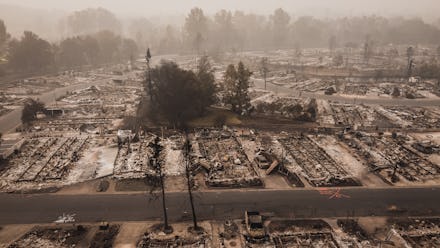Extreme weather cost the US almost $100 billion in damage last year

2020 seemed like the year that disasters just kept coming, and it came with a price tag that reflects that feeling. According to an analysis performed by insurance company Munich Re, the United States incurred $95 billion in damages caused by natural disasters in 2020, thanks at least in part to climate change's role in producing increasingly common instances of extreme weather events.
That nearly $100 billion figure in the US alone accounted for nearly half of the $210 billion of damage done globally, according to the report. The US saw its damage almost double from the year prior, in which it experienced $57 billion in weather-related losses. 2020 brought the third-highest level of damages experienced since 2010, and there's little expectation that things will get better in the near-term as the country struggles to get on track with its climate change goals.
The particularly destructive year was driven in large part by record-breaking disasters hounding the coasts of the US. Over on the Atlantic, 12 hurricanes made landfall in the US, an unprecedented number that shattered the previous record of nine, set back in 1916. Those storms caused a considerable amount of damage, destroying billions of dollars worth of property and infrastructure, killing hundreds, and forcing millions of people from their homes in search of shelter. Many of the storms, like Hurricane Laura and Hurricane Sally, carried with them massive storm surges that left entire communities underwater. In total, Munich Re estimates hurricanes did $13 billion in damage in the US last year.
Meanwhile, out West, wildfires ravaged California and many of its neighboring states. California suffered through its worst wildfire seasons on record, with nearly 10,000 individual fires spreading across the state. Those flames destroyed more than four million acres of land and scorched more than 10,000 buildings, many of which were peoples' homes. And while California got the worst of it, other fires spread in Oregon, Washington, and Colorado. It all amounted to the most destructive year by far for wildfires. Munich Re estimates that the country experienced about $16 billion in damages from these flames.
While there is no denying the devastating and destructive nature of the extreme weather hitting the coasts, it was the middle of the country that took the biggest hit financially. In August, a widespread, long-lived wind storm, sometimes called a derecho, swept across the Midwest. It brought with it torrential rain, large hail, and tornadoes. Iowa took the worst of the unexpected storm, which destroyed millions of acres of farmland. Areas of Nebraska, Illinois, Wisconsin, and Indiana were also affected. In total, an estimated $40 billion of damage was done by the storm despite it lasting a mere 14 hours.
Many, if not all, of these extreme weather events were made significantly worse by climate change. By continuing to pump greenhouse gases into the atmosphere, we are creating conditions under which these storms and fires thrive. The planet's increasing temperature exacerbates things, turning small weather events into big ones. It's how we end up with an entire coast on fire for months straight, or how 100 year floods start happening every single year. And odds are 2020 will not be an outlier but an indicator. Recent studies suggest that we may already have so much carbon pollution in the air that we will be unable to reverse course on climate change. If that's the case, $95 billion in damages from extreme weather might seem like a drop in the bucket in coming years.